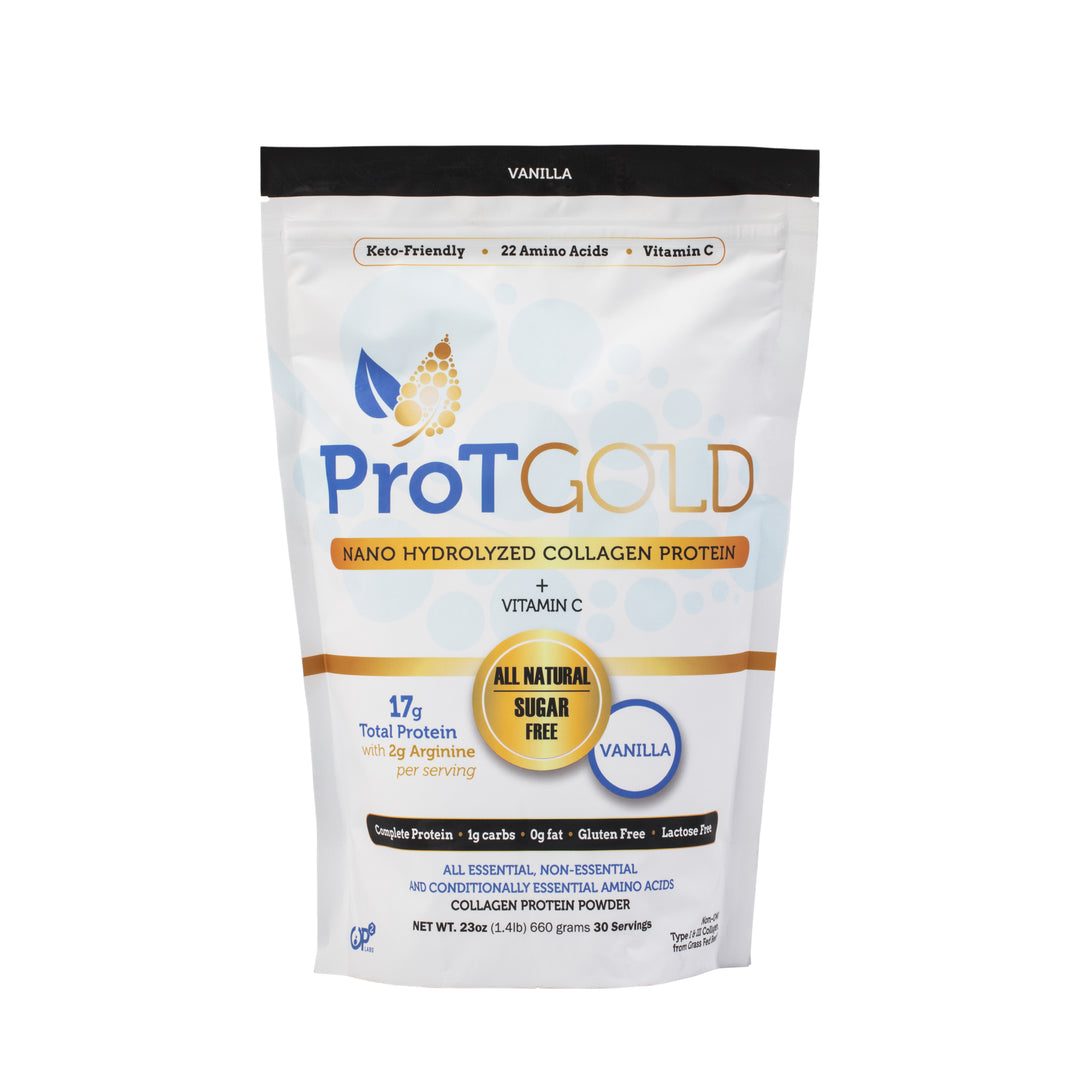Tips for Recognizing (and Treating) Early Signs of Arthritis
Arthritis is an incredibly common medical condition that can impact people of all ages. Fortunately, the inflammation and joint pain caused by this condition can easily be treated through diet, exercise, and collagen protein for arthritis relief.
Before we can start treating our arthritis, though, we need to have the tools to recognize that we have it. Knowing the signs and symptoms of arthritis can be tricky, especially since there are so many types of arthritis.
Let’s break down some of the most common forms of arthritis, as well as arthritis symptoms, so you understand what you have, and how to treat it.
Types of Arthritis
While we most frequently associate arthritis with aging, early-onset arthritis is also common. The causes and locations of arthritis will differ from person to person, but there will be some similarities for everyone.
Across the board, arthritis develops because shock-absorbing cartilage is no longer able to cushion your bones or joints properly. The type and severity of arthritis can vary greatly between people, but we can group arthritis symptoms into four categories.
Osteoarthritis
Osteoarthritis is thought to be the most commonly occurring form of arthritis and chronic joint pain. While osteoarthritis can occur in younger adults, it is far more likely to impact older people.
As we age, more stress and wear happens within our bodies, especially our joints. This stress can cause joints and cartilage to begin to deteriorate or become damaged.
Previous injuries to joints, obesity, joint malformation, poor posture, and deteriorating cartilage are all considered to be possible contributors to osteoarthritis. Because of these reasons, osteoarthritis is considered to be a degenerative condition.
Rheumatoid Arthritis
Rheumatoid arthritis, which is commonly referred to as RA, is actually an autoimmune disorder. In RA, your immune system begins to attack your joints and cartilage causing inflammation and pain.
Rheumatoid arthritis patients may experience periods where they have no symptoms, and then suddenly, experience an unprovoked flare-up. At this time, medical professionals are unsure about what causes the human immune system to attack the joints.
Although there is currently no cure for RA, there are ways to manage RA symptoms so you can still continue to do the things you love. We will discuss a few of them in more detail later, but the most commonly sought out treatments revolve around diet, exercise, meditation, and acupuncture.
Psoriatic Arthritis
Another autoimmune disorder, psoriatic arthritis (psoriasis), comes in a few different forms. It can present on your skin- causing irritating, red, and itchy patches - and can also attack your joints.
Doctors are beginning to believe that a mix of genetic and environmental factors contributes to the development of psoriatic arthritis. As there are different types of psoriasis, some people will experience symptoms similar to rheumatoid arthritis, while others will have isolated areas (spine, hands, or feet) affected by psoriasis.
Gout
You may be surprised to learn that gout is also a form of arthritis. The term gout is often used generically to describe conditions caused by the buildup of uric acid. This most commonly will occur in your feet.
While many patients that experience gout will have pain isolated to the joint in their big toe, many others will have joint pain throughout their feet and legs. Since there is a direct trigger to the flare-ups of gout, it can be more manageable than other forms of arthritis.
Recognizing Early Arthritis Symptoms
If you suspect that you may be experiencing arthritis symptoms, it is always best to consult a healthcare professional for a diagnosis. This is especially encouraged because each type of arthritis has slightly different causes.
Our goal is to provide you with the most commonly occurring symptoms of arthritis in its early stages. This way, you can stay ahead of your condition and begin treatment as soon as possible.
As there are many forms of arthritis, these arthritis symptoms below are by no means an exhaustive list. These are the ones that will generally appear first, though.
Pain & Tenderness
One of the first signs of arthritis is pain within a specific joint area. It could occur after you’ve done an activity, or as the seasons change. While joint pain may not always be isolated to one area, pay attention to areas that often feel a slight burning sensation, tenderness, or dull ache after activity.
Many people that develop arthritis in middle adulthood will experience pains in their hands, knees, and hips. You can experience pain outside of these areas of your body, but those are the most common.
Swelling & Redness
Much of the pain arthritis causes is because the joint itself is inflamed. You may be experiencing arthritis symptoms if you notice a joint area is often swollen.
We all have something called synovial fluid that acts as a natural cushion in our joints. Too much synovial fluid causes swelling when your natural cartilage is no longer able to provide that cushion for you.
Along with joint swelling and pain, the area may appear red and irritated.
Limited Area Mobility
When our joints aren’t functioning as they should, we may also have limited mobility. It is hard to find the desire to move and walk around when our knees are aching, swollen, and in pain.
With limited mobility, we must also consider that our range of motion may decrease as well. Beyond the joint pain, the swelling may become severe enough to prevent us from utilizing our joint’s full range of motion.
Numbness or Tingling
Numbness or tingling is most often an early sign of rheumatoid arthritis. However, it could be caused by other types of arthritis. Having a numb sensation in your hands or a specific joint area will generally be caused by swelling.
Continuous or intense amounts of swelling in joint areas may cause compression of your nerves. If this goes on for long enough, your nerves will begin to lose sensation, which causes numbness and tingling.
Collagen for Arthritis
When describing the different forms of arthritis and major causes, there was one significant commonality: joints and cartilage. All our joints and cartilage (and also our skin, tendons, and organs) contain a protein called collagen. Our bodies naturally produce collagen, but the amount we produce decreases as we age.
Our body’s collagen production starts to slow as early as age 25. As our bodies use up the collagen we have available, our body may struggle to repair or even maintain specific protein structures.
While we often think of arthritis as a condition that only inflicts the elderly, it isn’t surprising that even middle-aged adults may start to experience arthritis symptoms since collagen production slowed in their 20s.
Diet is an important part of managing any arthritis symptoms. One of the best diets for arthritis consists of nutrient-dense foods with anti-inflammatory properties. However, our body can be given the ability to repair itself through eating foods that boost natural collagen or adding in additional collagen for arthritis treatment.
Other Arthritis Treatments to Consider
Diet is a great way to take control of your arthritis symptoms and potentially curb some of the pain. Along with guidance from your physician, other things like exercise, acupuncture, massage, and meditation can become a part of your pain management routine.
Exercise
It can be hard to convince yourself to get up and move when your joints are hurting, but many low-impact exercises could help you manage your weight, keep joints flexible, and strengthen the muscles around your joints.
If you aren’t sure how to start an exercise routine, working with a physical therapist or personal trainer can ensure you’re doing the exercises that benefit your body.
Some examples of low-impact exercise include:
- Swimming
- Walking
- Cycling
- Yoga
- Tai Chi
Acupuncture and Massage
There isn’t conclusive evidence to suggest that acupuncture or massage is always beneficial to those that suffer from arthritis pain. However, these treatments have the potential to add some much-needed relief.
The best way to pursue this is to discuss it with your doctor and find a professional massage therapist and/or acupuncturist that you trust. It may take some trial and error to find the right area of focus, but both treatments pose a relatively low risk and can help relieve your arthritis symptoms.
Meditation
Meditation may seem like a strange addition to the treatment of arthritis pain, but both meditation and relaxation techniques have the potential to lessen stress. Reducing stress and managing anxiety and depression could also help decrease inflammation in parts of your body.
Connect with Others
When you first begin to experience the symptoms of arthritis, it can feel isolating and frustrating. Along with the other lifestyle treatments we described above, having a support group can help navigate this new aspect of your life.
If you are unable to find a local support group, you can always seek groups online to have a safe space to ask questions and express frustrations that come with managing your arthritis.
Managing Arthritis
Arthritis will impact every person a little differently, and so each treatment should be just as personalized. There is no one-size-fits-all when it comes to arthritis symptoms or treatment.
One of the simplest ways to manage your arthritis symptoms is through collagen supplements. If you’re interested in integrating collagen into your diet but aren’t sure where to start, our ProT Gold Liquid Collagen Protein is a nano-hydrolyzed collagen formula. It is ready to drink and designed for fast absorption, so it works wonderfully as supplemental collagen for arthritis relief. It’s also recommended by nearly 4,000 medical facilities for ailments such as arthritis so you know it’s a brand you can trust.









